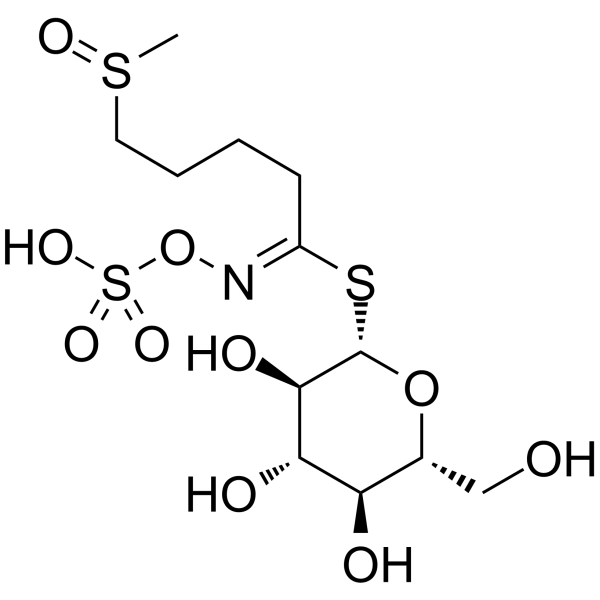天然产物 糖类和糖苷 Saccharides and Glycosides
Glucoraphanin; 纯度: 99.81%
Glucoraphanin 是存在于十字花科蔬菜中的硫代葡萄糖苷,是 Nrf2 诱导剂 sulforaphane 的前体,后者具有抗氧化、抗炎、抗癌的作用。

Glucoraphanin Chemical Structure
CAS No. : 21414-41-5
| 规格 | 价格 | 是否有货 | 数量 |
|---|---|---|---|
| 10;mM;*;1 mL in Water | ¥1595 | In-stock | |
| 5 mg | ¥1450 | In-stock | |
| 10 mg | ¥2600 | In-stock | |
| 50 mg | ; | 询价 | ; |
| 100 mg | ; | 询价 | ; |
* Please select Quantity before adding items.
Glucoraphanin 相关产品
bull;相关化合物库:
- Natural Product Library Plus
- Bioactive Compound Library Plus
- Immunology/Inflammation Compound Library
- Metabolism/Protease Compound Library
- NF-kappa;B Signaling Compound Library
- Stem Cell Signaling Compound Library
- Natural Product Library
- Anti-Cancer Compound Library
- Anti-Aging Compound Library
- Antioxidants Compound Library
- Glycoside Compound Library
- Oxygen Sensing Compound Library
- Ferroptosis Compound Library
- Pyroptosis Compound Library
- Mitochondria-Targeted Compound Library
- Food-Sourced Compound Library
| 生物活性 |
Glucoraphanin, a natural glucosinolate found in cruciferous vegetable, is a stable precursor of the Nrf2 inducer sulforaphane, which possesses antioxidant, anti-inflammatory, and anti-carcinogenic effects. |
||||||||||||||||
|---|---|---|---|---|---|---|---|---|---|---|---|---|---|---|---|---|---|
| 体内研究 (In Vivo) |
Glucoraphanin reduces weight gain and increases energy expenditure in HFD-fed mice. Glucoraphanin can improves insulin sensitivity and glucose tolerance in HFD-fed mice. However, Glucoraphanin does not exert antiobesity and insulin-sensitizing effects in Nrf2−/− Mice. Glucoraphanin blocks HFD-induced reduction of Ucp1 protein levels in white adipose depots of wild-type mice but not in Nrf2−/− mice. Glucoraphanin alleviates HFD-induced hepatic steatosis and oxidative stress. Glucoraphanin suppresses HFD-induced proinflammatory activation of macrophages in liver and adipose tissue. Glucoraphanin also decreases circulating LPS and the relative abundance of proteobacteria in the gut microbiomes of HFD-fed mice[1]. Mice with pellets including 0.1% Glucoraphanin (GF) significantly attenuates the decreased social avoidance time in stressed mice. In the 1% sucrose preference test (SPT), treatment with pellets including 0.1% GF significantly attenuates the decreased sucrose preference of stressed mice[2]. MCE has not independently confirmed the accuracy of these methods. They are for reference only. |
||||||||||||||||
| Clinical Trial |
|
||||||||||||||||
| 分子量 |
437.51 |
||||||||||||||||
| Formula |
C12H23NO10S3 |
||||||||||||||||
| CAS 号 |
21414-41-5 |
||||||||||||||||
| 运输条件 |
Room temperature in continental US; may vary elsewhere. |
||||||||||||||||
| 储存方式 |
|
||||||||||||||||
| 溶解性数据 |
In Vitro:;
H2O : ≥ 76.5 mg/mL (174.85 mM) * “≥” means soluble, but saturation unknown. 配制储备液
*
请根据产品在不同溶剂中的溶解度选择合适的溶剂配制储备液;一旦配成溶液,请分装保存,避免反复冻融造成的产品失效。 |
||||||||||||||||
| 参考文献 |
|
| Animal Administration [1] |
Male C57BL/6JSlc mice are 7 weeks of age. The Nrf2 knockout (Nrf2−/−) mouse strain is used in the assay. After 1 week of acclimation, mice are fed normal chow (NC) (containing 2.2% dextrinized cornstarch, 10% kcal from fat), NC containing 0.3% glucoraphanin (NC-GR) (containing 2.2% extract powder), an HFD (containing 2.2% dextrinized cornstarch, 60% kcal from fat), or an HFD containing 0.3% glucoraphanin (HFD-GR) (containing 2.2% extract powder) for 14 weeks. Both the NC and the HFD containing cornstarch or glucoraphanin are prepared. All mice studied are maintained on a 12-h light/dark cycle at 24-26°C with free access to water and food. MCE has not independently confirmed the accuracy of these methods. They are for reference only. |
|---|---|
| 参考文献 |
|
